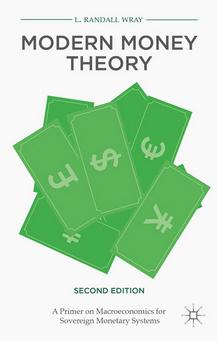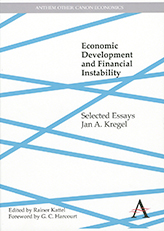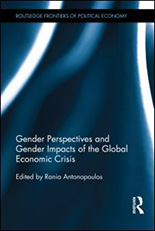
Research Topics
Publications on Macroeconomics
-
Macroeconomics
Book Series, February 2019 | February 2019This groundbreaking new core textbook encourages students to take a more critical approach to the prevalent assumptions around the subject of macroeconomics, by comparing and contrasting heterodox and orthodox approaches to theory and policy. The first such textbook to develop a heterodox model from the ground up, it is based on the principles of Modern Monetary Theory (MMT) as derived from the theories of Keynes, Kalecki, Veblen, Marx, and Minsky, amongst others. The internationally-respected author team offer appropriate fiscal and monetary policy recommendations, explaining how the poor economic performance of most of the wealthy capitalist countries over recent decades could have been avoided, and delivering a well-reasoned practical and philosophical argument for the heterodox MMT approach being advocated.
Published by: Red Globe PressAssociated Program:Author(s): -
Some Comments on the Sraffian Supermultiplier Approach to Growth and Distribution
Working Paper No. 907 | May 2018The paper discusses the Sraffian supermultiplier (SSM) approach to growth and distribution. It makes five points. First, in the short run the role of autonomous expenditure can be appreciated within a standard post-Keynesian framework (Kaleckian, Kaldorian, Robinsonian, etc.). Second, and related to the first, the SSM model is a model of the long run and has to be evaluated as such. Third, in the long run, one way that capacity adjusts to demand is through an endogenous adjustment of the rate of utilization. Fourth, the SSM model is a peculiar way to reach what Garegnani called the “Second Keynesian Position.” Although it respects the letter of the “Keynesian hypothesis,” it makes investment quasi-endogenous and subjects it to the growth of autonomous expenditure. Fifth, in the long run it is unlikely that “autonomous expenditure” is really autonomous. From a stock-flow consistent point of view, this implies unrealistic adjustments after periods of changes in stock-flow ratios. Moreover, if we were to take this kind of adjustment at face value, there would be no space for Minskyan financial cycles. This also creates serious problems for the empirical validation of the model.Download:Associated Programs:The State of the US and World Economies Monetary Policy and Financial Structure Explorations in Theory and Empirical AnalysisAuthor(s): -
“America First” and Financial Stability
Conference Proceedings, April 18-19, 2017 | April 2018A conference organized by the Levy Economics Institute of Bard College
The proceedings include the 2017 conference program, transcripts of keynote speakers’ remarks, synopses of the panel sessions, and biographies of the participants.Download:Associated Programs:Author(s):Michael Stephens -
The Economics of Instability
Working Paper No. 903 | April 2018An Abstract of an Excerpt
The dominant postwar tradition in economics assumes the utility maximization of economic agents drives markets toward stable equilibrium positions. In such a world there should be no endogenous asset bubbles and untenable levels of private indebtedness. But there are.
There is a competing alternative view that assumes an endogenous behavioral propensity for markets to embark on disequilibrium paths. Sometimes these departures are dangerously far reaching. Three great interwar economists set out most of the economic theory that explains this natural tendency for markets to propagate financial fragility: Joseph Schumpeter, Irving Fisher, and John Maynard Keynes. In the postwar period, Hyman Minsky carried this tradition forward. Early on he set out a “financial instability hypothesis” based on the thinking of these three predecessors. Later on, he introduced two additional dynamic processes that intensify financial market disequilibria: principal–agent distortions and mounting moral hazard. The emergence of a behavioral finance literature has provided empirical support to the theory of endogenous financial instability. Work by Vernon Smith explains further how disequilibrium paths go to asset bubble extremes.
The following paper provides a compressed account of this tradition of endogenous financial market instability.Download:Associated Program:Author(s):Frank Veneroso -
Quantitative Easing and Asset Bubbles in a Stock-flow Consistent Framework
Working Paper No. 897 | September 2017Ever since the Great Recession, central banks have supplemented their traditional policy tool of setting the short-term interest rate with massive buyouts of assets to extend lines of credit and jolt flagging demand. As with many new policies, there have been a range of reactions from economists, with some extolling quantitative easing’s expansionary virtues and others fearing it might invariably lead to overvaluation of assets, instigating economic instability and bubble behavior. To investigate these theories, we combine elements of the models in chapters 5, 10, and 11 of Godley and Lavoie’s (2007) Monetary Economics with equations for quantitative easing and endogenous bubbles in a new model. By running the model under a variety of parameters, we study the causal links between quantitative easing, asset overvaluation, and macroeconomic performance. Preliminary results suggest that rather than being pro- or countercyclical, quantitative easing acts as a sort of phase shift with respect to time.
-
Modern Money Theory: A Primer on Macroeconomics for Sovereign Monetary Systems, Second Edition
Book Series, September 2015 | September 2015By L. Randall Wray

In a completely revised second edition, Senior Scholar L. Randall Wray presents the key principles of Modern Money Theory, exploring macro accounting, monetary and fiscal policy, currency regimes, and exchange rates in developed and developing nations. Wray examines how misunderstandings about the nature of money caused the recent global financial meltdown, and provides fresh ideas about how leaders should approach economic policy. This updated edition also includes new chapters on tax policies and inflation.
Published by: Palgrave Macmillan
-
Marx’s Theory of Money and 21st-century Macrodynamics
Working Paper No. 841 | July 2015Marx’s theory of money is critiqued relative to the advent of fiat and electronic currencies and the development of financial markets. Specific topics of concern include (1) today’s identity of the money commodity, (2) possible heterogeneity of the money commodity, (3) the categories of land and rent as they pertain to the financial economy, (4) valuation of derivative securities, and (5) strategies for modeling, predicting, and controlling production and exchange of the money commodity and their interface with the real economy.
Download:Associated Program:Author(s): -
Economic Development and Financial Instability: Selected Essays
Book Series, October 2014 | October 2014By Jan A. Kregel. Edited by Rainer Kattel. Foreword by G. C. Harcourt.
 This volume is the first collection of essays by Jan Kregel focusing on the role of finance in development and growth, and it demonstrates the extraordinary depth and breadth of this economist’s work. Considered the “best all-round general economist alive” (Harcourt), Kregel is a senior scholar and director of the monetary policy and financial structure program at the Levy Economics Institute, and professor of development finance at Tallinn University of Technology. These essays reflect his deep understanding of the nature of money and finance and of the institutions associated with them, and of the indissoluble relationship between these institutions and the real economy—whether in developed or developing economies. Kregel has expanded Hyman Minsky’s original premise that in capitalist economies stability engenders instability, and Kregel’s key works on financial instability, its causes and effects, as well as his discussions of the global financial crisis and Great Recession, are included here.
Published by: Anthem Press
This volume is the first collection of essays by Jan Kregel focusing on the role of finance in development and growth, and it demonstrates the extraordinary depth and breadth of this economist’s work. Considered the “best all-round general economist alive” (Harcourt), Kregel is a senior scholar and director of the monetary policy and financial structure program at the Levy Economics Institute, and professor of development finance at Tallinn University of Technology. These essays reflect his deep understanding of the nature of money and finance and of the institutions associated with them, and of the indissoluble relationship between these institutions and the real economy—whether in developed or developing economies. Kregel has expanded Hyman Minsky’s original premise that in capitalist economies stability engenders instability, and Kregel’s key works on financial instability, its causes and effects, as well as his discussions of the global financial crisis and Great Recession, are included here.
Published by: Anthem Press
-
Endogenous Money and the Natural Rate of Interest
Working Paper No. 817 | September 2014The Reemergence of Liquidity Preference and Animal Spirits in the Post-Keynesian Theory of Capital Markets
Since the beginning of the fall of monetarism in the mid-1980s, mainstream macroeconomics has incorporated many of the principles of post-Keynesian endogenous money theory. This paper argues that the most important critical component of post-Keynesian monetary theory today is its rejection of the “natural rate of interest.” By examining the hidden assumptions of the loanable funds doctrine as it was modified in light of the idea of a natural rate of interest—specifically, its implicit reliance on an “efficient markets hypothesis” view of capital markets—this paper seeks to show that the mainstream view of capital markets is completely at odds with the world of fundamental uncertainty addressed by post-Keynesian economists, a world in which Keynesian liquidity preference and animal spirits rule the roost. This perspective also allows us to shed new light on the debate that has sprung up around the work of Hyman Minsky, calling into question to what extent he rejected the loanable funds view of financial markets. When Minsky’s theories are examined against the backdrop of the natural rate of interest version of the loanable funds theory, it quickly becomes clear that Minsky does not fall into the loanable funds camp.
Download:Associated Program:Author(s):Philip Pilkington -
Gender Perspectives and Gender Impacts of the Global Economic Crisis
Book Series, December 2013 | December 2013Edited by Rania Antonopoulos

With the full effects of the Great Recession still unfolding, this collection of essays analyzes the gendered economic impacts of the crisis. The volume, from an international set of contributors, argues that gender-differentiated economic roles and responsibilities within households and markets can potentially influence the ways in which men and women are affected in times of economic crisis.
Looking at the economy through a gender lens, the contributors investigate the antecedents and consequences of the ongoing crisis as well as the recovery policies adopted in selected countries. There are case studies devoted to Latin America, transition economies, China, India, South Africa, Turkey, and the United States. Topics examined include unemployment, the job-creation potential of fiscal expansion, the behavioral response of individuals whose households have experienced loss of income, social protection initiatives, food security and the environment, shedding of jobs in export-led sectors, and lessons learned thus far. From these timely contributions, students, scholars, and policymakers are certain to better understand the theoretical and empirical linkages between gender equality and macroeconomic policy in times of crisis.
Published by: Routledge
